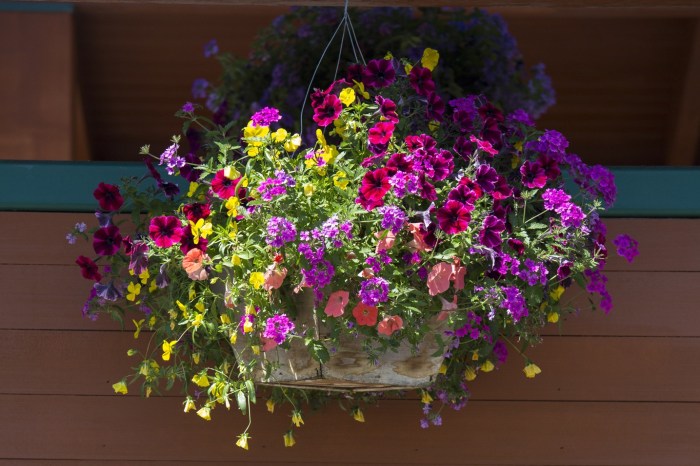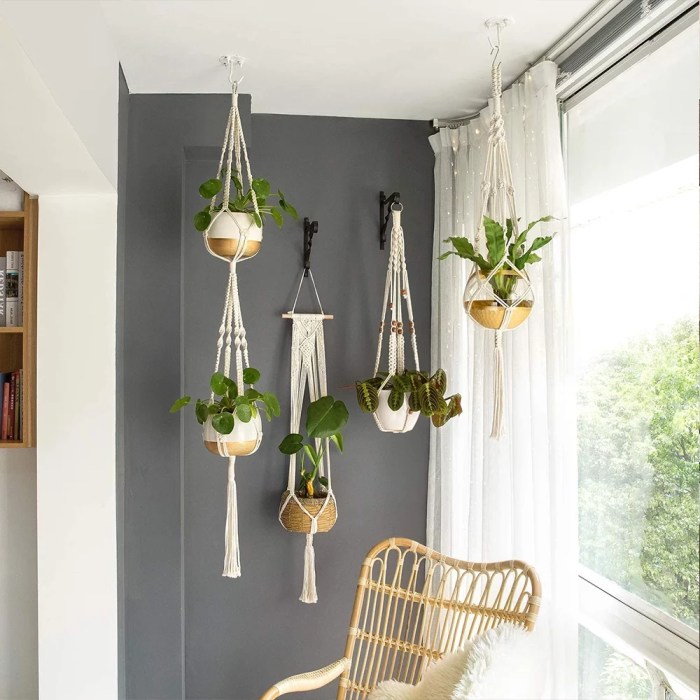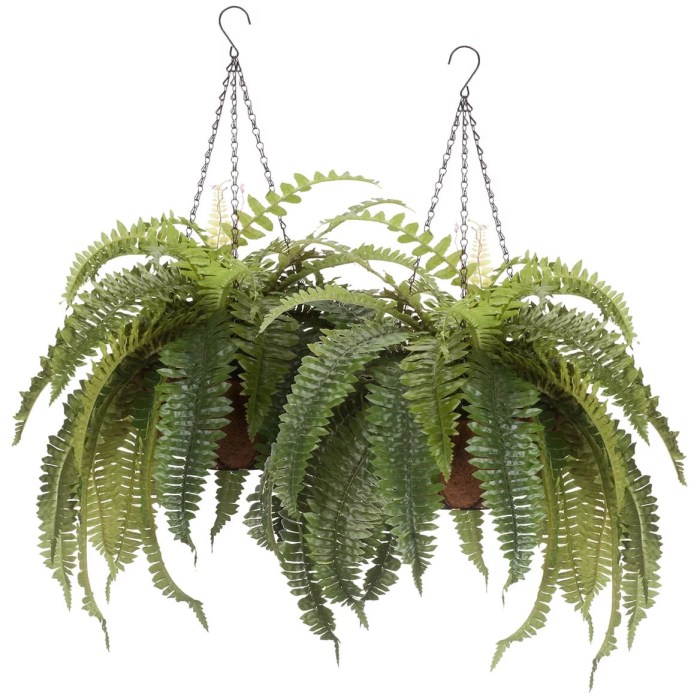Inside hanging baskets offer a unique way to add greenery and beauty to your home. Whether you’re looking to create a lush indoor oasis or simply add a touch of nature to a small space, inside hanging baskets are a versatile and stylish solution.
In this guide, we’ll cover everything you need to know about inside hanging baskets, from choosing the right plants and baskets to planting and care tips. We’ll also share some creative ideas for hanging basket arrangements and provide step-by-step instructions for creating your own DIY hanging baskets.
Plant Selection: Inside Hanging Baskets
When selecting plants for inside hanging baskets, it is crucial to consider factors such as the amount of light the area receives, the frequency of watering required, and the growth habit of the plant.
For areas with ample bright, indirect light, suitable plant choices include:
- Ferns, such as Boston fern, maidenhair fern, and bird’s nest fern
- Trailing plants, such as ivy, pothos, and philodendron
- Bromeliads, such as guzmania and Vriesea
- African violets
For areas with limited light, consider low-light tolerant plants such as:
- Snake plant
- ZZ plant
- Peace lily
- Aspidistra
Regarding watering needs, some plants prefer moist soil, while others tolerate drier conditions. Choose plants that align with the frequency of watering you can provide.
Finally, consider the growth habit of the plant. Some plants have a cascading or trailing growth habit, making them ideal for hanging baskets, while others have an upright growth habit and may not be as suitable.
Inside hanging baskets, a variety of plants can thrive, adding a touch of greenery to any indoor space. For those seeking stylish and functional options, basket planters for indoor plants come in a range of materials and designs, complementing both modern and traditional interiors.
These baskets provide ample space for roots to grow, while the hanging feature allows for efficient use of vertical space, creating a lush indoor oasis.
Basket Design

Hanging baskets come in a wide variety of materials, shapes, and sizes. The most common materials are plastic, metal, and wicker. Plastic baskets are lightweight and durable, but they can fade in the sun. Metal baskets are strong and sturdy, but they can rust.
Inside hanging baskets can be a beautiful addition to any home, adding a touch of greenery and life to any room. Whether you’re looking for a way to add some color to your living space or simply want to enjoy the benefits of indoor plants, Hanging Plants Indoor has everything you need to get started.
From tips on choosing the right plants to advice on how to care for them, Hanging Plants Indoor is your one-stop resource for all things hanging baskets.
Wicker baskets are natural and attractive, but they can be more expensive than other types of baskets.
Baskets come in a variety of shapes, including round, square, and oval. Round baskets are the most popular, but square and oval baskets can be more space-efficient. Baskets also come in a variety of sizes, from small baskets that can hold a few plants to large baskets that can hold a dozen or more plants.
When choosing a hanging basket, it is important to consider the weight of the plants you will be planting, the drainage needs of the plants, and the aesthetics of the basket. Heavier plants will require a stronger basket, and plants that require good drainage will need a basket with drainage holes.
Basket Materials
- Plastic:Lightweight, durable, but can fade in the sun.
- Metal:Strong and sturdy, but can rust.
- Wicker:Natural and attractive, but can be more expensive.
Basket Shapes
- Round:Most popular, but square and oval baskets can be more space-efficient.
- Square:Space-efficient, but can be less attractive than round baskets.
- Oval:Space-efficient and attractive, but can be more expensive than round baskets.
Basket Sizes
- Small:Can hold a few plants.
- Medium:Can hold several plants.
- Large:Can hold a dozen or more plants.
Planting Techniques
Planting inside hanging baskets requires careful preparation and attention to detail to ensure the health and beauty of your plants. Follow these steps for successful planting:
Soil Preparation
Hanging baskets require well-draining soil to prevent waterlogging. Use a commercial potting mix specifically designed for hanging baskets or create your own by mixing equal parts peat moss, perlite, and compost.
Plant Placement, Inside hanging baskets
Arrange plants in the basket according to their growth habit and light requirements. Taller plants should go in the center, with trailing plants cascading over the sides. Consider the mature size of plants when spacing them to avoid overcrowding.
Watering Techniques
Hanging baskets dry out quickly, so regular watering is essential. Water deeply until water drains from the bottom of the basket. Allow the top inch of soil to dry out between waterings. Use a watering can with a long spout to reach the center of the basket.
Inside hanging baskets, plants with long, trailing stems add a touch of elegance and movement. These long trailing plants , such as ivy, ferns, and spider plants, cascade over the edges of the basket, creating a lush and eye-catching display.
By incorporating these plants into your hanging baskets, you can add a touch of nature and create a visually stunning addition to your home or outdoor space.
Maintaining Healthy Plants
To keep your hanging basket plants thriving, follow these tips:
- Fertilize regularly with a balanced liquid fertilizer according to the manufacturer’s instructions.
- Monitor for pests and diseases and treat promptly with appropriate organic or chemical solutions.
- Deadhead spent flowers to encourage new growth and prevent seed production.
- Prune overgrown or leggy plants to maintain a compact and attractive shape.
Creative Arrangements

Hanging baskets offer a unique opportunity to create visually stunning displays that add color and life to any space. By incorporating trailing plants, vertical elements, and thoughtful color combinations, you can transform your hanging baskets into eye-catching focal points.
Trailing Plants
Trailing plants, with their graceful cascades of foliage and flowers, add a touch of elegance and movement to hanging baskets. Popular choices include ivy, petunias, and lobelia. These plants can be allowed to trail over the sides of the basket, creating a lush and inviting display.
Vertical Elements
Incorporating vertical elements into hanging baskets creates a sense of height and drama. You can achieve this by using tall, upright plants such as foxgloves, delphiniums, or spiky foliage plants like yucca or dracaena. These plants draw the eye upward and add a touch of grandeur to your arrangements.
Color Combinations
Color plays a crucial role in creating visually appealing hanging baskets. Consider using contrasting colors for maximum impact, such as bright reds and purples or soft pinks and blues. You can also create a monochromatic look by using different shades of the same color, resulting in a harmonious and elegant display.
Inside hanging baskets, lush greenery and vibrant blooms create a captivating display. One particularly striking choice is the hanging snake plant . Its long, cascading leaves add a touch of elegance and sophistication to any indoor space. The snake plant’s hardiness and adaptability make it an ideal choice for hanging baskets, as it can tolerate a wide range of conditions and requires minimal care.
DIY Projects
Creating unique hanging baskets using recycled materials or repurposed items is a fun and sustainable way to add a touch of greenery to your home or garden. With a little creativity and some basic materials, you can easily transform old containers or discarded objects into beautiful and functional hanging planters.
Here are some step-by-step instructions for creating your own DIY hanging baskets:
Repurposing Old Containers
- Tin cans:Clean and remove any labels from tin cans. Punch holes in the bottom for drainage and attach a wire or twine handle. You can paint or decorate the cans to match your desired style.
- Plastic bottles:Cut the bottom off a plastic bottle and make holes around the rim for hanging. Fill the bottle with soil and plants, and hang it upside down.
- Yogurt containers:Cut a hole in the bottom of a yogurt container and insert a plant. Decorate the container with paint or fabric to create a unique look.
Using Repurposed Items
- Old tires:Clean and paint an old tire to create a rustic hanging planter. Attach a chain or rope to the tire for hanging.
- Wooden pallets:Cut a section from a wooden pallet and attach hooks or wires for hanging. Fill the pallet with soil and plants, creating a vertical garden effect.
- Fabric scraps:Sew together fabric scraps to create a hanging pouch for plants. Attach a rope or chain to the pouch for hanging.
Closing Notes

With a little creativity and care, you can create beautiful and thriving inside hanging baskets that will add a touch of nature and beauty to your home.
User Queries
What are the best plants for inside hanging baskets?
There are many plants that are well-suited for inside hanging baskets, including ferns, trailing plants, and succulents. Some popular choices include Boston ferns, spider plants, pothos, and succulents like echeveria and sedum.
How do I choose the right hanging basket?
When choosing a hanging basket, consider the size and weight of the plants you plan to use, as well as the style of your home. Baskets made from materials like metal, plastic, or wicker are all popular choices.
How do I plant and care for inside hanging baskets?
To plant inside hanging baskets, fill the basket with a well-draining potting mix and make a hole in the center large enough to accommodate the plant’s root ball. Gently remove the plant from its pot and place it in the hole, backfilling with potting mix and tamping down gently to secure the plant.
Water the plant thoroughly and allow the excess water to drain.